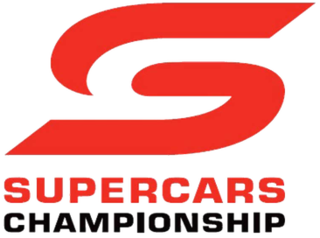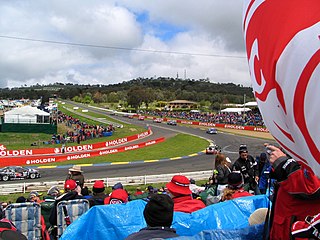
The Supercars Championship is a touring car racing category in Australia, running as an International Series under Fédération Internationale de l'Automobile (FIA) regulations, governing the sport.

Motorsport is a popular spectator sport in Australia, although there are relatively few competitors compared to other sports due to the high costs of competing. The oldest motorsport competition in Australia is the Alpine Rally which was first staged in 1921 followed by the Australian Grand Prix, first staged in 1928. The most widely watched motorsport category is Supercars, especially at the Bathurst 1000. Other classes in Australia include Australian GT, Formula 3 and Formula Ford, Superbikes, as well as various forms of speedway racing.
The 1981 Australian Touring Car Championship was a CAMS sanctioned motor racing title for drivers of Group C Touring Cars. The championship, which was the 22nd running of the Australian Touring Car Championship, began at Symmons Plains Raceway and ended at Lakeside International Raceway after 8 rounds.
The 1994 Australian Manufacturers' Championship was a CAMS sanctioned motor racing competition for 2.0 Litre Touring Cars complying with FIA Class II rules. The championship, which was promoted as the 1994 Valvoline Australian Manufacturers' Championship, began on 17 April 1994 at Eastern Creek Raceway and ended on 28 August at Oran Park Raceway after six rounds. The series determined both the winning automobile manufacturer in the 22nd Australian Manufacturers' Championship and the winning driver in the second annual Australian title for drivers of Class II Touring Cars. This title was awarded as the Australian 2.0 Litre Touring Car Championship in 1993 and as the Australian Super Touring Championship from 1995.
The 1991 Australian Touring Car Championship was a CAMS sanctioned motor racing title open to Group 3A Touring Cars. The title, which was the 32nd Australian Touring Car Championship, was contested over a nine-round series which began on 24 February 1991 at Sandown Raceway and ended on 11 August at Oran Park Raceway, The series was promoted as the Shell Australian Touring Car Championship and was won by Jim Richards driving a Nissan Skyline GT-R.
The 1996 BOC Gases Australian Super Touring Championship was the fourth running of a touring car series in Australia under the Super Touring Car regulations. It began on 19 May 1996 at Amaroo Park and ended on 9 November at Oran Park Raceway after sixteen races.
The 1993 Australian Touring Car Championship was a CAMS sanctioned Australian motor racing title for Group 3A Touring Cars. The championship, which was the 34th Australian Touring Car Championship, was contested over a nine-round series which began on 28 February 1993 at Amaroo Park and ended on 8 August at Oran Park Raceway. Promoted as the Shell Australian Touring Car Championship, it was won by Glenn Seton, driving a Ford EB Falcon, with teammate Alan Jones completing a one-two championship result for Glenn Seton Racing. It was Seton's first championship victory and the first major victory for the team he had started in 1989.
The 1998 Australian Touring Car Championship was an Australian motor racing competition open to 5.0 Litre Touring Cars,. The championship, which was sanctioned by the Confederation of Australian Motor Sport as an Australian title, was contested over a ten-round series which began on 1 February 1998 at Sandown International Motor Raceway and ended on 2 August at Oran Park International Raceway. The series was promoted as the "Shell Australian Touring Car Championship". The title, which was the 39th Australian Touring Car Championship, was won by Craig Lowndes.
The 1998 Australian Super Touring Championship was the sixth running of a CAMS sanctioned motor racing series in Australia under the Super Touring Car regulations and the fourth to carry the Australian Super Touring Championship name. It began on 5 April 1998 at Calder Park Raceway and ended on 30 August at Oran Park Raceway after eight rounds. The series was promoted by TOCA Australia as the 1998 BOC Gases Australian Super Touring Championship. As in the British Touring Car Championship the race format changed with each meeting now consisting a shorter "sprint" race and a "feature" race, 25% longer than previous races featuring a mandatory two-tyre stop to be taken between 15 and 75% distance. The one exception was the round at Lakeside Raceway where the pit lane was deemed unsuitable.
The 1986 Australian Endurance Championship was a CAMS sanctioned motor racing title open to Touring Cars as specified in the National Competition Rules of CAMS. The title, which was the sixth Australian Endurance Championship, was contested concurrently with the 1986 Australian Manufacturers' Championship, which was the sixteenth in a sequence of manufacturers championships awarded by CAMS, and the seventh to be contested under the Australian Manufacturers' Championship name.
The 1988 Australian Touring Car Championship was a CAMS sanctioned motor racing title for drivers of Group 3A Touring Cars. It was the 29th running of the Australian Touring Car Championship. The championship began on 6 March at Calder Park Raceway and ended on 17 July at Oran Park Raceway after nine rounds.
The 2000 Australian Super Touring Car Championship was a CAMS sanctioned motor racing competition open to Super Touring Cars. It was the eighth running of an Australian series for Super Touring Cars and the sixth to be contested under the Australian Super Touring Championship name. The series, which was promoted as the '2000 BOC Gases Australian Super Touring Championship', began on 28 May 2000 at Oran Park Raceway and ended on 11 February 2001 at Oran Park Raceway after eight rounds.
The 1979 Australian Touring Car Championship was a CAMS sanctioned Australian motor racing title open to Group C Touring Cars. It began at Symmons Plains and ended at Adelaide International Raceway after eight rounds. The title, which was the 20th Australian Touring Car Championship, was won by Bob Morris driving a Holden Torana.
The 1982 Australian Touring Car Championship was a CAMS sanctioned Australian motor racing title open to Group C Touring Cars. It began on 18 February 1982 at Sandown Raceway and ended on 16 May at Oran Park Raceway after eight rounds. The title, which was the 23rd Australian Touring Car Championship, was won by defending champion Dick Johnson, driving a Ford XD Falcon.
The 1977 Australian Touring Car Championship was a CAMS sanctioned Australian motor racing championship open to Group C Touring Cars. It was the 18th running of the Australian Touring Car Championship. The championship began at Symmons Plains Raceway on 7 March and ended at the Phillip Island Grand Prix Circuit on 20 November after eleven rounds. 1977 was the second and final time that the series incorporated the longer distance races which made up the Australian Championship of Makes. These races included the Sandown 400 and the Phillip Island 500K, although notably not the Bathurst 1000.
The 2009 Australian Drivers' Championship was a CAMS sanctioned national motor racing title with the championship winner receiving the 2009 CAMS Gold Star award. The 2009 championship was the 53rd Australian Drivers' Championship and the fifth to be contested with open wheel racing cars constructed in accordance with FIA Formula 3 regulations. The season began on 19 March 2009 at the Adelaide Street Circuit and finished on 29 November at Sandown Raceway after eight events across four different states with two rounds per event. Team BRM driver Joey Foster became the second successive champion from Great Britain, holding off 2007 series champion Tim Macrow by eight points. In the National classes, Tom Tweedie was champion in National A, recording three top-three overall finishes and twelve class wins, while Peter Kalpakiotis was champion in National B as he was the only driver to contest more than one meeting.
The 1997 Australian Drivers' Championship was a motor racing competition open to drivers of racing cars complying with CAMS Formula Holden regulations. The championship winner was awarded the 1997 CAMS Gold Star as the Australian Drivers' Champion. It was the 41st running of the Australian Drivers' Championship, and the ninth to feature the Formula Holden category which had been developed during 1988. The championship began on 15 March 1997 at the Calder Park Raceway and ended on 3 August at Oran Park Raceway after seven rounds of a series which was promoted as the "Holden Australian Drivers Championship".
The 1985 Australian Sports Car Championship was a CAMS sanctioned motor racing title for drivers of Group A Sports Cars. It was the 17th Australian Sports Car Championship and the first to be run concurrently with the Australian GT Championship.
The 2011 Australian Drivers' Championship was a CAMS sanctioned national motor racing title with the championship winner receiving the 2011 CAMS Gold Star award. It was the 55th Australian Drivers' Championship and the seventh to be contested with open wheel racing cars constructed in accordance with FIA Formula 3 regulations. It was also recognised as the 11th Australian Formula 3 Championship. The championship was contested over a series which was officially known as the "2011 Australian Formula 3 Drivers Championship for the CAMS Gold Star". The series began on 21 March 2011 at Winton Motor Raceway and finished on 13 November at Symmons Plains Raceway after seven rounds across five different states and territories, with three races at each round.
The 2002 Australian Super Touring Car Series was a CAMS sanctioned motor racing competition open to Super Touring Cars. It was the tenth running of an Australian series for Super Touring Cars and the second to be contested under the Australian Super Touring Series name. The series began on 24 March 2002 at Oran Park Raceway and ended on 24 November 2002 at Oran Park Raceway after five rounds. It would be the final season for such touring cars until the 2019 TCR Australia Touring Car Series, which is a contemporary take on the four-cylinder touring car formula.

